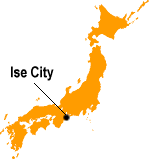

 |
||

|
2000 Years of History, Yet Never Gets Older
Than 20
 Jingu Shrine in Ise City, Mie Prefecture, consists of two major shrines, Naiku (Inner Shrine) and Geku (Outer Shrine), and other affiliated shrines. The Inner Shrine enshrines Amaterasu Omikami, the sun goddess, from whom the imperial family claimed descent, and the Outer Shrine, about six kilometers (3.7 miles) away from the other, is dedicated to Toyouke, the goddess of agriculture and sericulture. Legend says that the shrine has been standing for 2000 years. As the most ancient and most sacred of the Shinto shrines in Japan, the Jingu Shrine has always been held in high esteem by the Japanese people. Perhaps the most remarkable point about the Ise Shrine is the rite of "shikinen sengu" in which the wooden shrine buildings are razed and completely rebuilt, and rededicated to the enshrined goddesses every 20 years. The custom was established in the 7th century and has continued since the first rebuilding in 690. The sixty-first rebuilding was completed in 1993. The visiting public are allowed to approach the main building only once every twenty years at a ceremony prior to the rededication, a rare opportunity to experience the solemnity of the shrine.  At both the Inner and Outer Shrines, the central compound is divided into two sections for alternate use in each period of 20 years. Building a new shrine of plain hinoki (Japanese cypress) wood takes about eight years, and each stage of the construction is accompanied by a religious ceremony. The carpentry work is carried out by about one hundred men, the majority of whom are local carpenters who set aside their usual work for a privileged period of two to four years. No nails are used in the entire structure. Although the plans exist for every structure, the master carpenters must remember and pass on to apprentices their expert knowledge of how to put together the complex joints, using ancient and unfamiliar tools. Photos: (Top) The building of the Inner Shrine (Ise Shrine); Uji Bridge in the Inner Shrine, also rebuilt every twenty years (Mie Prefecture). Unauthorized reproduction of the
photos in this page is prohibited.
Related Links: |
|

